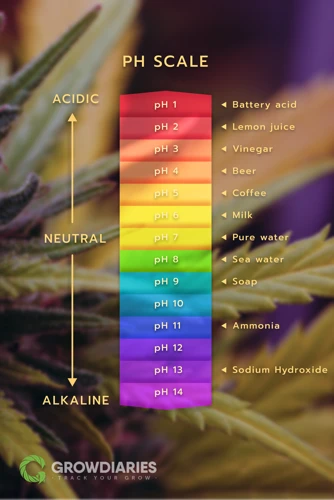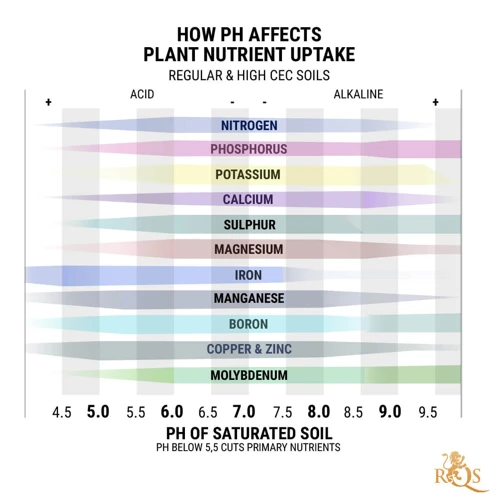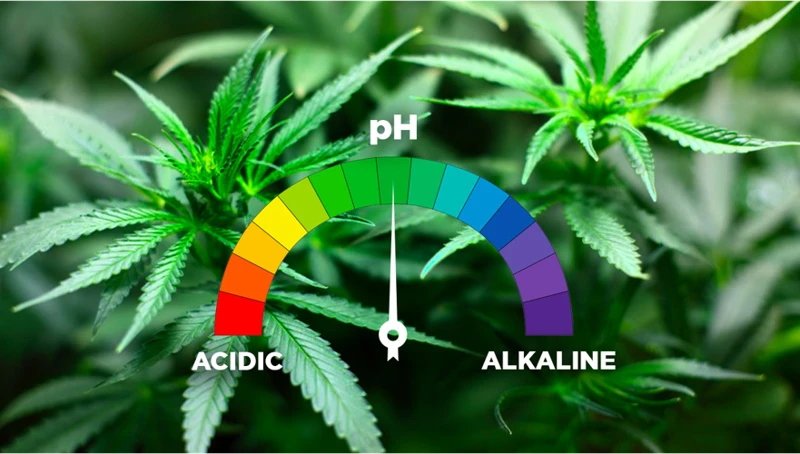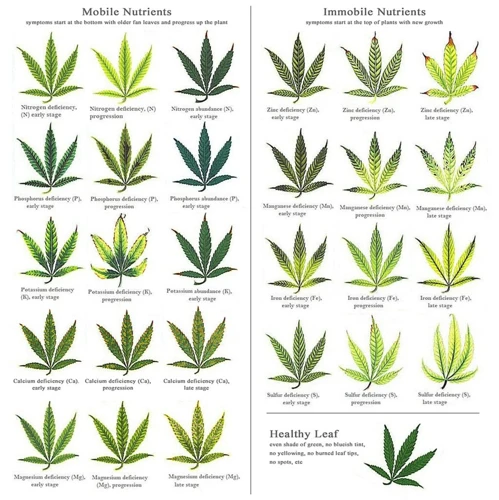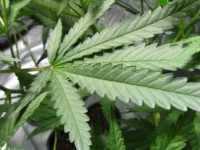
Balancing pH Levels for Optimal Cannabis Growth
As a cannabis grower, you may have encountered some issues with your plants, such as yellowing leaves or stunted growth. Despite providing the best nutrients and care, you wonder why your plants seem to be struggling. The answer may lie in the pH levels of your growing medium. pH plays a critical role in cannabis growth, affecting how nutrients are absorbed and utilized by the plant. In this article, we will delve into the importance of pH in cannabis growth, how to test and adjust pH levels, and how to prevent nutrient imbalances that may arise from pH issues. By the end, you will have a comprehensive understanding of how to balance pH levels to ensure healthy and flourishing cannabis plants.
The Importance of pH in Cannabis Growth
Contents
Maintaining the proper pH levels is crucial for the healthy growth of cannabis plants. This is a perplexing topic for many growers, but it is essential to understand how pH levels can impact nutrient uptake, and ultimately the yield and quality of your harvest. In this section, we will explore the importance of pH in cannabis growth, including what pH is and why it’s important, the effects of pH on nutrient absorption, and the optimal pH range for cannabis growth. By the end of this section, you’ll have a deeper understanding of why pH is a critical factor in cannabis cultivation and how it can affect the overall health of your plants. To further bolster your expertise, we will help identify nutrient deficiencies and toxicities that can manifest in your cannabis garden because of pH imbalances.
What is pH and Why is it Important?
The pH level is a measurement of the acidity or alkalinity of a solution, ranging from 0 to 14. A pH of 7 is considered neutral, lower than 7 is acidic, and higher than 7 is alkaline. The pH level of the growing medium is crucial to cannabis growth because it affects nutrient uptake and the plant’s ability to access the vital elements necessary for growth.
When the pH is too low, cannabis plants cannot uptake the macronutrients necessary for healthy growth and development such as nitrogen, phosphorus, and potassium. This can result in stunted growth or yellowing of the leaves, known as nitrogen deficiencies. On the other hand, when the pH is too high, cannabis plants can experience nutrient lockout, where minerals and nutrients in the growing medium become inaccessible to the plant.
Proper pH levels are essential to ensure the optimal absorption of all nutrients, including essential macronutrients and micronutrients such as calcium and magnesium. Calcium and magnesium deficiencies are common in cannabis plants, resulting in slow growth, yellowing leaves or spotting on leaves, and may also cause stunted growth. Calcium and magnesium deficiencies can be prevented by maintaining proper pH levels in the growing medium and supplementing with calcium and magnesium supplements.
It is important to maintain stable pH levels in the soil and growing medium to ensure that the cannabis plant has access to all the necessary nutrients it needs to grow and produce high-quality buds.
In the next section, we will explore the effects of pH levels on nutrient absorption in cannabis plants and the optimal pH range for cannabis growth.
The Effects of pH on Nutrient Absorption in Cannabis
The pH level of the growing medium has a significant effect on the absorption of nutrients by the cannabis plants. When the pH level is not within the appropriate range, certain nutrients may become unavailable to the plant, even if they are present in the soil or nutrient solution.
This is because different nutrients have different optimal pH levels for absorption. The table below shows the optimal pH ranges for absorption of important nutrients by cannabis plants:
| Nutrient | Optimal pH Range |
|---|---|
| Nitrogen (N) | 5.5 – 7.0 |
| Phosphorus (P) | 6.0 – 7.5 |
| Potassium (K) | 5.5 – 7.0 |
| Calcium (Ca) | 6.0 – 7.0 |
| Magnesium (Mg) | 6.0 – 7.0 |
| Zinc (Zn) | 5.5 – 6.5 |
If the pH level of the growing medium is too high or too low, certain nutrients will become less available to the plant. For example, if the pH is too low, the plant may not be able to absorb enough calcium, which can lead to calcium or magnesium deficiencies. On the other hand, if the pH is too high, the plant may not be able to absorb enough phosphorus, which can result in phosphorus toxicity.
To avoid nutrient imbalances and deficiencies, it is important to maintain the optimal pH range for cannabis growth. By regularly testing and adjusting the pH level of the growing medium, growers can ensure that their plants are able to absorb all the nutrients they need for healthy growth and development.
The Optimal pH Range for Cannabis Growth
The optimal pH range for cannabis growth is crucial for ensuring that plants can properly absorb nutrients and thrive. Managing pH levels can be quite complicated but is also an essential aspect of cannabis production.
As a general rule of thumb, the ideal pH range for cannabis growth is between 6.0 and 7.0. This range ensures that the plant can properly absorb nutrients such as nitrogen, phosphorus, and potassium.
It is essential to keep in mind that different growing media have varying optimal pH ranges. Here is a table that outlines the optimal pH range for cannabis growth in different mediums:
| Growing Medium | Optimal pH Range |
|---|---|
| Soil | 6.0 – 7.0 |
| Coco coir | 5.5 – 6.5 |
| Hydroponics | 5.5 – 6.5 |
It’s important to note that pH levels will naturally fluctuate during the growing process, and it’s essential to maintain a consistent pH balance to prevent nutrient deficiencies or toxicities.
In addition to monitoring pH levels, growers should also keep track of other factors that can influence pH levels, such as water quality and the type of nutrients used.
Understanding the optimal pH range for cannabis growth is vital for maintaining healthy plants and preventing nutrient imbalances. With the proper management of pH levels, growers can produce high-quality cannabis crops that are healthy and thriving.
How to Test pH Levels
As a cannabis grower, ensuring that your plants are healthy and thriving is essential for a successful harvest. One important aspect of plant growth is maintaining proper pH levels in the soil or growing medium. pH levels impact nutrient absorption, and imbalances can lead to nutrient deficiencies or toxicities. But how do you test the pH levels of your growing environment? Don’t worry, we’ve got you covered. In this section, we’ll discuss different methods for testing pH levels and provide tips for when and how often to test.
pH Test Kits: How Do They Work?
pH Test Kits: How Do They Work?
There are several tools available for measuring the pH level of your cannabis growth medium, including digital pH meters and testing strips. However, pH test kits are the most common and affordable option for most growers.
- The most basic pH test kit typically includes a test tube, a dropper, and a solution of pH indicator liquid.
- To use the kit, you simply add a small amount of your growth medium to the test tube, add a few drops of the indicator solution, and then observe the color change.
- The color change of the indicator solution will correspond to a pH level on a color chart that is provided with the kit.
It is important to note that different pH test kits may require slightly different techniques. Be sure to carefully read and follow the instructions that come with your specific kit.
While pH test kits are affordable and easy to use, they do have some downsides:
- They may not be as accurate as digital pH meters.
- They may not be as sensitive as testing strips, which can detect smaller pH changes.
- The indicator solution may expire or become contaminated over time, which can affect the accuracy of your results.
Despite these limitations, pH test kits remain a popular choice for many cannabis growers due to their ease of use and affordability.
When to Test pH Levels
Testing pH levels is an important aspect of cannabis cultivation. Without checking pH, the plants may not be able to correctly absorb nutrients, leading to nutrient imbalances and other problems. Here are some key points to keep in mind when determining when to test pH levels:
- Test pH levels frequently: pH levels can change rapidly, so it is recommended to test the pH levels of the growing medium at least once a day, particularly during the early stages of growth.
- Test pH levels after adding nutrients: adding nutrients can alter the pH levels of the growing medium, which can affect the plant’s ability to uptake nutrients. After adding any nutrients or supplements, it is important to test the pH levels to ensure they are within the optimal range.
- Test pH levels in different areas: it is important to test pH levels in different areas of the growing medium to ensure there are no hot spots or nutrient imbalances. Testing pH levels at different depths will also give a more accurate reading of the overall pH level of the growing medium.
- Test pH levels when encountering problems: if the plants are showing signs of nutrient deficiencies or toxicity, it is important to test the pH levels immediately to determine if that is the cause of the problem.
- Test pH levels before and after adjusting: before making any adjustments to pH levels, it is important to test the pH level to determine how much of an adjustment is needed. After making adjustments, test pH levels again to ensure they are within the optimal range.
Testing pH levels may seem daunting at first, but it is an essential part of keeping the plants healthy and avoiding nutrient imbalances. By testing pH levels frequently and at different stages of growth, cultivators can ensure their plants receive the nutrients they need to thrive.
How to Adjust pH Levels
Maintaining the proper pH level in a cannabis grow is essential to ensure optimal nutrient uptake and avoid nutrient imbalances. However, if you find that your pH is too high or too low, you may be wondering how to adjust it. There are several methods to bring your pH levels back into the acceptable range, ranging from using pH up and pH down solutions to natural methods of pH adjustment. But with so many options available, it can be perplexing to know what method to choose. In this section, we’ll outline the different methods of pH adjustment and explore some troubleshooting tips to help you maintain optimal pH levels in your cannabis grow.
Using pH Up and pH Down Solutions
Maintaining proper pH levels is crucial for healthy cannabis plants. pH Up and pH Down solutions are essential tools for growers to adjust the pH levels in their growing medium.
pH Up Solutions are used to increase the pH levels of acidic solutions. Commonly used pH Up solutions are sodium hydroxide (NaOH) and potassium hydroxide (KOH). These solutions should be used carefully and in small quantities, as they can be highly caustic and can cause burns to the skin and eyes. It is important to use protective gear such as gloves and goggles when handling pH Up solutions.
pH Down Solutions are used to decrease the pH levels of alkaline solutions. Commonly used pH Down solutions are phosphoric acid (H3PO4) and citric acid. These solutions are less caustic than pH Up solutions, but they should still be handled with care and in well-ventilated areas. It is recommended to start with small amounts and gradually add more if necessary.
Before using pH Up or pH Down solutions, it is crucial to perform a pH test to determine the current pH level and the appropriate amount of solution needed to adjust it. It is recommended to make small adjustments at a time and frequently test the pH levels to avoid overcorrection.
| Possible pH Adjustment | Amount of Solution Needed per Gallon of Water |
|---|---|
| From pH 8.0 to pH 7.0 | 2 ml of pH Down Solution or 1 ml of pH Up Solution |
| From pH 8.0 to pH 6.0 | 4 ml of pH Down Solution or 2 ml of pH Up Solution |
| From pH 8.0 to pH 5.0 | 6 ml of pH Down Solution or 3 ml of pH Up Solution |
It is important to note that pH Up and pH Down solutions can affect the nutrient availability in the growing medium. Using too much of either solution can cause nutrient imbalances, leading to deficiencies or toxicities. It is recommended to adjust the pH levels gradually and frequently test the nutrient levels to ensure a healthy balance for the plants.
In addition to pH Up and pH Down solutions, there are also natural methods to adjust pH levels such as using compost teas, organic acids, or limestone. However, these methods may take longer to adjust pH levels and may not be as precise as using pH Up and pH Down solutions.
Using pH Up and pH Down solutions is a simple and effective method to maintain proper pH levels for cannabis growth. With proper usage and frequent testing, growers can avoid nutrient imbalances and promote healthy plant growth.
Using Natural Methods to Adjust pH Levels
When adjusting pH levels, many growers prefer using natural methods over pH up and pH down solutions. Vinegar and lemon juice can be used to lower pH levels, as they have natural acidic properties. However, it’s important to note that they should be used sparingly and with caution, as they can also harm the plant if overused.
Baking soda can be used to raise pH levels, as it has natural alkaline properties. However, like vinegar and lemon juice, it should be used sparingly to avoid damaging the plant.
Aloe vera and compost tea are also natural options for adjusting pH levels. Aloe vera contains natural enzymes that help balance pH levels, while compost tea can introduce beneficial microorganisms that aid in nutrient absorption and pH regulation.
It’s important to note that natural methods may not be as precise as pH up and pH down solutions, so it’s important to regularly test pH levels and make adjustments as necessary. Additionally, natural methods may take longer to take effect compared to pH up and pH down solutions.
| Natural Method | Pros | Cons |
|---|---|---|
| Vinegar/Lemon Juice | Natural acidic properties | Can harm plant if overused |
| Baking Soda | Natural alkaline properties | Should be used sparingly to avoid plant damage |
| Aloe Vera | Contains natural enzymes that help balance pH levels | May not be as precise as pH up and pH down solutions |
| Compost Tea | Introduces beneficial microorganisms that aid in nutrient absorption and pH regulation | May take longer to take effect |
Ultimately, the choice between natural methods and pH up and pH down solutions depends on the individual grower’s preferences and growing conditions. It’s important to regularly monitor and adjust pH levels to avoid nutrient imbalances and ensure the health and growth of your cannabis plants.
Maintaining pH Levels Throughout the Growing Cycle
As any experienced grower will tell you, maintaining proper pH levels throughout the entire growing cycle is absolutely essential for healthy cannabis plants. Failure to do so can lead to nutrient imbalances, stunted growth, and lower yields. Whether you are growing in soil, hydroponics, or any other medium, it’s crucial to stay on top of your pH levels to ensure your plants are getting the nutrients they need. But it’s not just a matter of adjusting pH once and forgetting about it; maintaining pH levels throughout the growing cycle requires a bit of knowledge and attention. Let’s dive in!
pH Levels in Different Growing Mediums
Maintaining the correct pH levels is essential in all growing mediums to avoid nutrient imbalances and ensure optimal cannabis growth. However, pH levels can vary depending on the type of growing medium used. In this section, we will discuss the optimal pH levels for different growing mediums and how to adjust them.
Soil: Soil is a common growing medium for cannabis and has a naturally occurring range of pH levels. The optimal pH range for soil is between 6.0 and 7.0. If the pH level is too high or too low, it can prevent the absorption of certain nutrients. To adjust the pH level in soil, use pH up or pH down solutions as needed.
Coco coir: Coco coir is another popular growing medium for cannabis that has similar properties to soil. The optimal pH range for coco coir is slightly lower than soil, between 5.5 and 6.5. Coco coir tends to retain more water than soil, so it is important to check the pH level regularly and adjust as needed.
Rockwool: Rockwool is a growing medium made from volcanic rock that is heated and spun into fibers. The optimal pH range for rockwool is between 5.5 and 6.5. Rockwool has a high water retention capacity and can hold onto salts, which can lead to pH fluctuations. It is important to check the pH level frequently and adjust as necessary.
Hydroponics: Hydroponic systems use a nutrient solution instead of a growing medium. The optimal pH range for hydroponics is between 5.5 and 6.5. In hydroponic systems, the pH level can fluctuate rapidly, so it is crucial to check and adjust pH levels daily.
To summarize, different growing mediums have different optimal pH ranges. It is vital to monitor the pH levels regularly, adjust as necessary and prevent nutrient imbalances. The following table illustrates the optimal pH ranges for various growing mediums:
| Growing Medium | Optimal pH Range |
|---|---|
| Soil | 6.0 – 7.0 |
| Coco coir | 5.5 – 6.5 |
| Rockwool | 5.5 – 6.5 |
| Hydroponics | 5.5 – 6.5 |
pH Levels in Hydroponic Systems
Hydroponic systems are becoming increasingly popular for cannabis growing because they allow for precise control over growing conditions, including pH levels. However, it’s important to understand the unique considerations when it comes to maintaining pH levels in hydroponic setups.
pH Range: The pH range for hydroponic systems should be between 5.5 and 6.5 for optimal nutrient absorption.
| Issue | Cause | Solution |
|---|---|---|
| Nutrient Imbalances | Uneven pH levels in different parts of the hydroponic system can lead to nutrient imbalances and plant stress. | Regularly check and adjust pH levels throughout the system, and consider using a recirculating pump to ensure consistent distribution of nutrients. |
| Algae Growth | Higher pH levels in hydroponic systems can promote the growth of algae, which can compete with cannabis plants for nutrients. | Keep pH levels in the optimal range, and consider using a UV sterilizer or hydrogen peroxide treatment to control algae growth. |
| Root Rot | High pH levels can increase the risk of root rot, which is caused by harmful bacteria that thrive in alkaline environments. | Monitor pH levels closely and adjust as needed to keep them within the optimal range. |
Note: It’s also important to use pH-stabilized water in hydroponic setups to minimize fluctuations and maintain consistency in pH levels.
Maintaining pH Levels During the Flowering Stage
Maintaining proper pH levels during the flowering stage of cannabis growth is crucial for a successful harvest. During this stage, plants are more susceptible to nutrient imbalances and pH fluctuations, which can negatively impact the quality and yield of the final product. It is important to carefully monitor and adjust pH levels to ensure that the plant is able to absorb the necessary nutrients during this critical stage of growth.
Optimal pH Range During Flowering Stage
The optimal pH range for cannabis plants during the flowering stage is between 6.0 and 7.0. At this pH level, the plant is able to absorb the necessary nutrients for optimal growth and flowering. If the pH is too low or too high, the plant may experience nutrient deficiencies or toxicities, which can stunt growth and reduce yields.
pH Testing and Adjusting
Regular pH testing and adjusting is necessary during the flowering stage to ensure that the plants are receiving the correct amount of nutrients. This can be done using pH test kits and adjusters, which are readily available at most gardening stores.
It is important to avoid sudden or extreme pH adjustments, as this can shock the plant and cause damage to the roots. Gradual adjustments should be made over time, and pH levels should be checked frequently to ensure that they stay within the optimal range.
Fluctuations in pH Levels
Fluctuations in pH levels are common during the flowering stage, and can be caused by a variety of factors, including changes in temperature, humidity, and watering habits. It is important to monitor pH levels closely to catch any fluctuations early on, and make adjustments as necessary.
One way to prevent pH fluctuations is to maintain a stable environment for the plants, with consistent temperatures, humidity levels, and watering routines. Additionally, using high-quality growing mediums and nutrients can also help to stabilize pH levels throughout the flowering stage.
Conclusion
Maintaining proper pH levels during the flowering stage is critical for ensuring optimal growth and yield. Regular testing and adjusting, along with careful monitoring of environmental factors, can help to prevent nutrient imbalances and ensure a successful harvest.
Preventing Nutrient Imbalances
One common challenge that cannabis growers face during the cultivation process is nutrient imbalances. When key nutrients like nitrogen, phosphorus, or potassium are in short supply or become excessive, it can lead to stunted growth, yellowing leaves, and lower yields. Balancing pH levels is a critical step in avoiding nutrient imbalances, as pH affects nutrient uptake and utilization by the plant. In this section, we will discuss how to prevent nutrient imbalances, identify nutrient deficiencies and toxicities, and prevent nutrient lockout. By following these guidelines, you can ensure a healthy and abundant harvest.
Identifying Nutrient Deficiencies and Toxicities
One of the most important aspects of maintaining the health of your cannabis plants is ensuring that they are getting the proper nutrients. However, it is equally important to prevent nutrient imbalances, which can lead to deficiencies and toxicities that can harm the plants. Here are some common signs of nutrient deficiencies and toxicities to look out for:
- Nitrogen Deficiency: Yellowing of older leaves, slow growth rate, and thin stems are all signs of a nitrogen deficiency.
- Phosphorus Deficiency: Dark green or purple leaves, weak stalks, and stunted growth are all signs of a phosphorus deficiency.
- Potassium Deficiency: Yellowing and curled tips of older leaves, and weak stems are all signs of a potassium deficiency.
- Calcium Deficiency: Yellowing or browning of new leaves, and distorted growth are all signs of a calcium deficiency.
- Magnesium Deficiency: Yellowing between the veins of older leaves, and stunted growth are all signs of a magnesium deficiency.
- Sulfur Deficiency: Yellowing of new leaves and stunted growth are all signs of a sulfur deficiency.
- Iron Deficiency: Yellowing of new leaves and stunted growth are all signs of an iron deficiency.
- Manganese Deficiency: Yellowing and withering of new leaves, and stunted growth are all signs of a manganese deficiency.
- Zinc Deficiency: Yellowing between the veins of new leaves, and stunted growth are all signs of a zinc deficiency.
- Copper Deficiency: Discoloration and distortion of new leaves are all signs of a copper deficiency.
On the other hand, nutrient toxicities can also occur if plants are overfed:
- Nitrogen Toxicity: Leaves become dark green and can appear burned or damaged.
- Phosphorus Toxicity: Symptoms are similar to a phosphorus deficiency.
- Potassium Toxicity: Leaves become yellow or brown and can appear burned or damaged.
- Calcium Toxicity: Symptoms can be similar to a calcium deficiency.
- Magnesium Toxicity: Leaves become yellow or bronze and can appear burned or damaged.
- Sulfur Toxicity: Symptoms are similar to a sulfur deficiency.
- Iron Toxicity: Leaves may appear dark green and can appear burned or damaged.
- Manganese Toxicity: Brown spots can appear on leaves and growth can be stunted.
- Zinc Toxicity: Leaves can become discolored and growth can be stunted.
- Copper Toxicity: Symptoms are similar to a copper deficiency.
A proper balance of nutrients is crucial to the overall health of your cannabis plants. It is important to regularly check the pH levels and adjust them accordingly to prevent nutrient imbalances.
How pH Levels Affect Nutrient Uptake
The pH level of the growing medium can significantly affect nutrient uptake in cannabis plants. It is essential to maintain the optimal pH range to prevent nutrient imbalances and promote healthy plant growth. This table shows how pH levels affect the availability of different nutrients to the plant:
| Nutrient | Optimal pH Range | Deficiency Symptoms | Toxicity Symptoms |
|---|---|---|---|
| Nitrogen (N) | 5.5 – 6.5 | Yellowing leaves, stunted growth | Brown and crunchy leaves, slowed growth |
| Phosphorus (P) | 6.0 – 7.0 | Purple stems, slow growth | Brown and burnt leaf tips, stunted growth |
| Potassium (K) | 6.0 – 7.0 | Yellowing and browning of leaf edges, poor bud development | Brown and burnt leaf edges, slowed growth |
| Calcium (Ca) | 6.2 – 7.2 | Stunted growth, yellowing of new leaves | Brown and burnt leaf tips, slowed growth |
| Magnesium (Mg) | 6.2 – 7.0 | Yellowing between leaf veins, stunted growth | Brown and burnt leaf tips, slowed growth |
| Sulfur (S) | 6.0 – 7.5 | Yellowing of new leaves, stunted growth | Brown and burnt leaf tips, slowed growth |
| Iron (Fe) | 5.5 – 6.5 | Yellowing between leaf veins, slowed growth | Blackening or burning of leaf tips, slowed growth |
| Zinc (Zn) | 6.0 – 7.0 | Yellowing between leaf veins, slowed growth, small leaves | Brown and burnt leaf edges, slowed growth |
As seen in the table, each nutrient has its optimal pH range for maximum availability to the plant. When the pH is too high or too low, the nutrients become less available, which can result in nutrient deficiencies or toxicities. It is crucial to monitor and maintain the pH level to avoid such imbalances and promote healthy cannabis growth.
Preventing Nutrient Lockout
Preventing nutrient lockout is crucial to maintaining a healthy and thriving cannabis plant. Nutrient lockout occurs when the pH level of the growing medium is outside of the optimal range for nutrient absorption. This can result in the plant being unable to uptake essential nutrients, even if they are present in the growing medium. Here are some ways to prevent nutrient lockout:
- Monitor pH Levels: As mentioned earlier, pH plays a critical role in nutrient absorption. It is important to consistently monitor pH levels and adjust them accordingly to prevent nutrient lockout.
- Use Quality Nutrients: Using high-quality nutrients ensures that the plant is receiving the necessary nutrients in a form that is easy for it to uptake. Poor quality nutrients can lead to nutrient lockout, even if the pH levels are within the optimal range.
- Flush the Plant: If you suspect that your plant is experiencing nutrient lockout, it can be helpful to flush it with pH-balanced water. This helps to remove any build-up of excess nutrients in the growing medium, allowing the plant to start fresh with a clean slate.
- Adjust pH levels Gradually: Rapid changes in pH levels can shock the plant and cause nutrient lockout. It is important to adjust pH levels gradually and monitor the plant’s response.
- Avoid Overfeeding: Overfeeding can lead to nutrient lockout and other plant health issues. It is important to follow the recommended feeding schedule for your specific nutrient regimen and adjust as necessary based on the plant’s response.
By taking these steps to prevent nutrient lockout, you can ensure that your cannabis plants are receiving the necessary nutrients for healthy growth and development.
Troubleshooting pH Issues
Maintaining the correct pH levels is critical for the healthy growth of cannabis plants. In spite of best efforts, it is possible to encounter pH issues during the growth cycle. It is crucial to be able to identify and rectify them as quickly as possible to prevent any damage to the plants. In this section, we will explore some common pH issues that growers may face and how to troubleshoot them effectively. Let’s dive into the nitty-gritty of pH troubleshooting!
pH Fluctuations: Causes and Solutions
It’s not uncommon for pH levels to fluctuate during the growing cycle of cannabis plants, and many factors can contribute to these fluctuations. Here are a few common causes of pH fluctuations and some solutions to keep pH levels stable:
- Poor quality water: If you’re using tap water or well water that has a high mineral content or pH, it can throw off your pH levels. Consider using filtered or distilled water instead.
- Overuse of nutrients: Overusing nutrients can cause a build-up of salts and minerals in the growing medium, making it difficult for plants to absorb nutrients and throwing off the pH balance. Make sure to follow a nutrient schedule and avoid overfeeding.
- Algae growth: Algae growth in the growing medium can cause pH levels to rise. Avoid overwatering and consider using an organic algae control product.
- Root rot: Root rot can cause a decrease in the plant’s ability to absorb nutrients, leading to pH fluctuations. Make sure to maintain proper drainage and avoid overwatering.
- Inconsistent feeding schedule: Inconsistent feeding can lead to pH fluctuations, especially in hydroponic systems. Make sure to follow a consistent feeding schedule and check pH levels regularly.
If you notice pH fluctuations despite taking preventative measures, there are a few solutions to stabilize pH:
- Flush the growing medium: Flushing the growing medium with pH-balanced water can help remove excess salts and minerals and bring pH levels back in line.
- Adjusting nutrient levels: Adjust nutrient levels to prevent overfeeding and ensure plants have the proper balance of nutrients for healthy growth.
- Using pH stabilizers: pH stabilizers are available that help maintain a stable pH even if there are fluctuations in the growing medium or nutrient solution.
By identifying the causes of pH fluctuations and taking the necessary steps to prevent and correct them, you can avoid nutrient imbalances and cultivate healthy, high-yielding cannabis plants.
Common pH Issues and How to Fix Them
One of the most common issues that growers face when it comes to pH levels is fluctuations, which can lead to nutrient imbalances and ultimately affect the overall health and yield of the cannabis plants. Here are some common pH issues and how to fix them using various methods:
| Issue | Symptoms | Solution |
|---|---|---|
| High pH Level | Yellow leaves, stunted growth | Use a pH down solution to lower the pH level of the water or growing medium. Alternatively, you can try adding organic acids such as white vinegar or citric acid to the water to naturally lower the pH level |
| Low pH Level | Brown spots on the leaves, slow growth | Use a pH up solution to increase the pH level of the water or growing medium. Alternatively, you can add alkaline substances such as baking soda or agricultural lime to raise the pH level |
| pH Fluctuations | Fluctuating pH levels or pH drifts | Regularly test and adjust the pH level of the water or growing medium. You can also use a pH stabilizer to keep the pH level consistent |
| Nutrient Lockout | Deficiencies in certain nutrients, slow growth | Flush the growing medium with pH-balanced water to remove any excess salts or nutrients that may be causing the lockout. Adjust the pH level before adding nutrients to avoid future lockouts |
It is important to regularly monitor and adjust pH levels to avoid these common issues and ensure that the cannabis plants are receiving the proper nutrients they need for healthy growth. By following these simple solutions, growers can maintain optimal pH levels and prevent nutrient imbalances in their cannabis plants.
Conclusion
In conclusion, balancing pH levels is crucial for the successful growth of cannabis plants. Maintaining the optimal pH range ensures that nutrients are absorbed efficiently, preventing nutrient deficiencies and toxicities. Testing pH levels regularly and adjusting as needed can prevent nutrient lockout and keep plants healthy throughout the growing cycle.
pH test kits are readily available and easy to use, allowing growers to monitor pH levels in their growing medium or hydroponic system. pH adjusters such as pH Up and pH Down solutions can be used to fine-tune pH levels, and natural methods like adding vinegar, lemon juice, or baking soda can also be effective.
It’s important to note that pH levels can vary depending on the growing medium and the stage of growth. For example, hydroponic systems tend to require more frequent pH monitoring and adjustments compared to soil-grown plants. During the flowering stage, pH levels may fluctuate, and maintaining proper levels can be especially important for maximizing yield and potency.
In order to prevent nutrient imbalances, it’s important to identify and address any nutrient deficiencies or toxicities as soon as possible. Maintaining proper pH levels can help prevent these imbalances from occurring in the first place.
Despite best efforts, pH issues can still arise. Common problems include pH fluctuations, nutrient lockout, and nutrient imbalances. Understanding the causes of these issues and knowing how to address them can help growers troubleshoot and prevent further problems.
Overall, balancing pH levels is an essential aspect of successful cannabis growth. With regular monitoring and adjustments, growers can maintain healthy plants and achieve optimal yields and potency.
Frequently Asked Questions
What is the optimal pH range for cannabis growth?
The optimal pH range for cannabis growth is between 6.0 and 7.0.
How often should I test pH levels?
You should test pH levels at least once a week during the vegetative stage, and every few days during the flowering stage.
How do pH test kits work?
pH test kits work by using a chemical indicator that changes color depending on the acidity or alkalinity of a liquid sample.
What is nutrient lockout?
Nutrient lockout occurs when a plant is unable to absorb nutrients due to imbalanced pH levels.
Can I adjust pH levels naturally?
Yes, you can adjust pH levels naturally by using substances like baking soda or vinegar, although it may not be as precise as using pH up and pH down solutions.
What can cause pH fluctuations in my growing system?
pH fluctuations can be caused by factors such as improper nutrient ratios, poor water quality, or insufficient buffering capacity in your growing medium.
How can I prevent nutrient deficiencies or toxicities?
You can prevent nutrient deficiencies or toxicities by regularly monitoring pH levels, using high-quality nutrients, and ensuring proper drainage and aeration in your growing system.
What are the common signs of nutrient imbalances?
Signs of nutrient imbalances include yellowing or browning of leaves, stunted growth, and unusual spotting or discoloration.
Can pH levels differ in different growing mediums?
Yes, pH levels can differ in different growing mediums such as soil, coco coir, or hydroponic solutions.
When should I maintain pH levels during the flowering stage?
You should maintain pH levels throughout the flowering stage, as this is when your plants will require the most nutrients and pH imbalances can cause significant damage to your yields.


